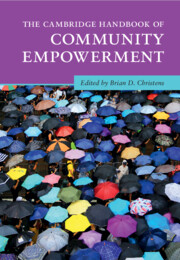Book contents
- The Cambridge Handbook of Community Empowerment
- Cambridge Handbooks in Psychology
- The Cambridge Handbook of Community Empowerment
- Copyright page
- Contents
- Figures
- Tables
- Contributors
- Building Community Power
- Part I Organizing and Activism
- 1 Youth Organizing
- 2 Youth Activism in Postapartheid South Africa
- 3 Domestic Violence and Community Organizing in India
- 4 Congregation-Based Community Organizing
- 5 Immigrant Organizing and Activism
- 6 Online Racial Justice Advocacy
- Part II Participatory Governance
- Part III Civil Society and Coalitions
- Part IV Enterprise
- Part V Participatory and Community Arts
- Part VI Education and Engaged Research
- Contributor Details
- Index
- References
4 - Congregation-Based Community Organizing
from Part I - Organizing and Activism
Published online by Cambridge University Press: 18 April 2024
- The Cambridge Handbook of Community Empowerment
- Cambridge Handbooks in Psychology
- The Cambridge Handbook of Community Empowerment
- Copyright page
- Contents
- Figures
- Tables
- Contributors
- Building Community Power
- Part I Organizing and Activism
- 1 Youth Organizing
- 2 Youth Activism in Postapartheid South Africa
- 3 Domestic Violence and Community Organizing in India
- 4 Congregation-Based Community Organizing
- 5 Immigrant Organizing and Activism
- 6 Online Racial Justice Advocacy
- Part II Participatory Governance
- Part III Civil Society and Coalitions
- Part IV Enterprise
- Part V Participatory and Community Arts
- Part VI Education and Engaged Research
- Contributor Details
- Index
- References
Summary
Community organizing within local faith-based institutions (churches, synagogues, mosques, etc.) is now widespread in the US and has seen adoption in several other countries. As congregation-based organizing has grown and matured as a field over four decades, leaders have drawn strong connections between the social and political goals of community organizing and the religious traditions and values of the participating congregations. This blending of organizing practices and religious traditions has been crucial to the success of this approach. This chapter describes some of the practices that congregation-based community organizing initiatives employ to build power among residents who are actively participating in defining and deciding how to alter the systems that affect their lives. A statewide organizing federation (PICO California) and the reflections of influential organizer Jose Carrasco serve as a case example of the intertwining of interfaith values with a power-based organizing approach.
- Type
- Chapter
- Information
- The Cambridge Handbook of Community Empowerment , pp. 110 - 138Publisher: Cambridge University PressPrint publication year: 2024



